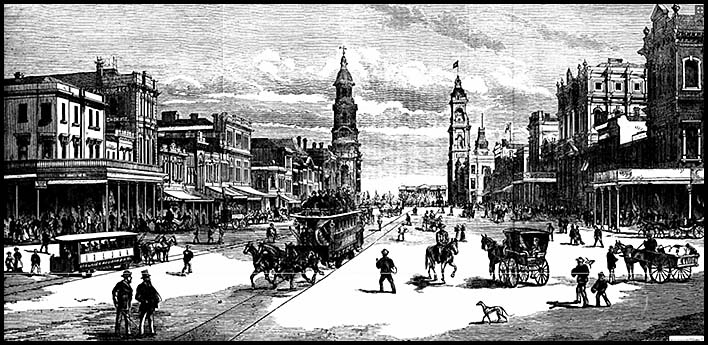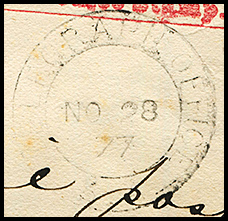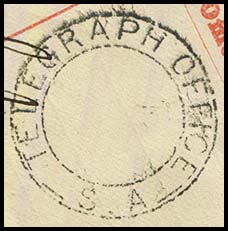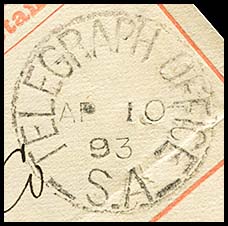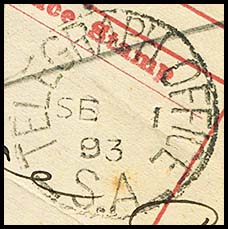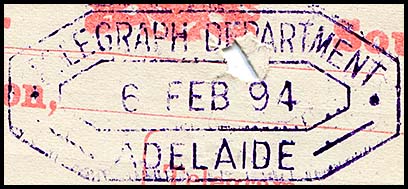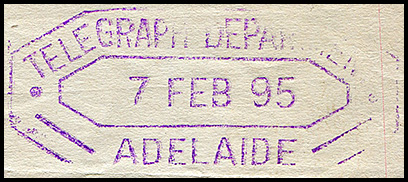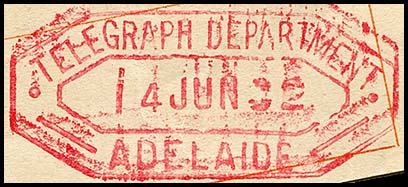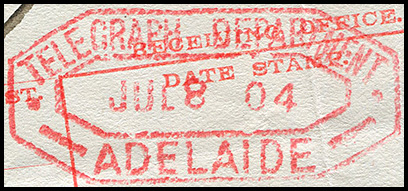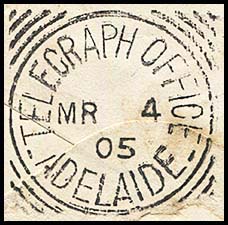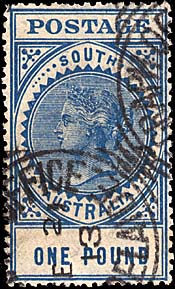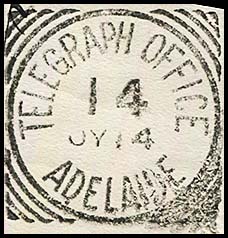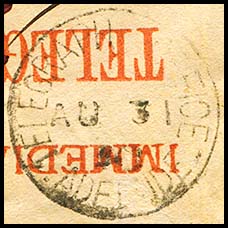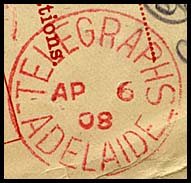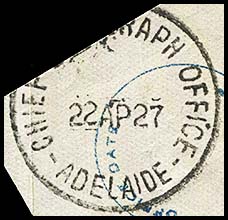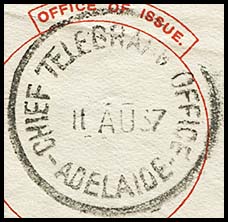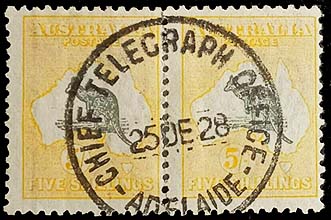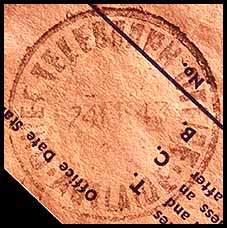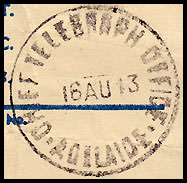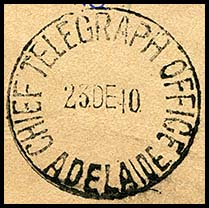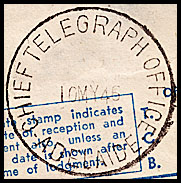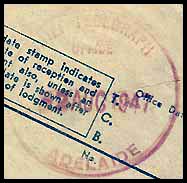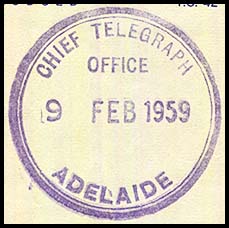General Post Office and the Chief Telegraph Office - Adelaide.
- Australia 1901-1988
- New South Wales
- Queensland
- South Australia
- Tasmania
- Victoria
- Western Australia
- International
- Special aspects
Details included on this page are:
- The General Post Office;
- The Chief Telegraph Office;
- Colonial date stamps used at the CTO:
Telegraph Office/S.A.;
Telegraph Department (Octagonal).
- Interim/post Federation date stamps used at the CTO:
- Telegraph Office/Adelaide (Squared circle);
- Telegraph Office/Adelaide (circular);
- Telegraphs Adelaide;
- Chief Telegraph Office (steel);
- Chief Telegraph Office (rubber);
- C.T.O Adelaide (unboxed);
- G.P.O. Adelaide;
- Adelaide/Sth. Austr. (Squared circle);
- Adelaide/Sth. Austr. (circle).
- See also the following Slogan Cancellations used at Adelaide:
* Send a Telegram;
* Send Birthday Greetings by Telegraph ...;
* Convey Congratulations by Telegraph ...;
* 100 Years Celebration ...;
* A Telegraphic Code Address ...;
* Other slogans used at Adelaide.
General Post Office, Adelaide.
When Adelaide was first surveyed in 1837, a site for the Post Office was reserved on the corner of King William and Franklin Streets. Thomas Gilbert (the Colonial Storekeeper since 13 July 1836) was appointed as the first Postmaster on 10 April 1837 - four months after the foundation of the Colony. His home - on the banks of the Torrens near where the Adelaide railway now meets the Hills railway - became the first Adelaide Post Office. His salary was set by Governor Hindmarsh at £30 a year.
In the following year, the Post Office location had to be moved because of the significant increase in business being conducted. The new location was Gillies Arcade and shortly after Gilbert resigned. A new postmaster - Henry Watts - was appointed and soon after the location was moved to rooms adjoining his home at No 37 North Terrace (corner of King William Street) where the Bank of New South Wales (now Westpac) later erected its Offices. In 1841, Henry Watts' brother John was appointed Postmaster-General. Then, in July 1848, the Post Office was moved again - this time across the road to where the Gresham Hotel now stands.
Scanned from Frearson's Monthly Illustrated reproduced in Adelaide News of 1 October 1880. |
It was however only a short stay because in 1851, the Post Office was again moved to its designated site on the corner of King William and Franklin Streets. Construction of this building took place between 1848 and 1851 with the clock tower being completed in 1854. The building housed the Metropolitan Police Station, the Court House and the Post Office. The entrances to the former two departments were in Franklin Street. Later the clock was removed to make space for the new telegraph office.
Lieutenant Henry Watts of the 47th Regiment succeeded Thomas Gilbert as Postmaster on 11 December 1838. On his retirement, Watts was replaced by James William Lewis on 29 June 1861 and he "retired" in 1870 when the decision was taken to amalgamate the Post Office and the Electric Telegraph Department. Lewis, although highly respected, was forced out in questionable circumstances.
The Superintendent of Telegraphs Mr. (later Sir) Charles Todd was appointed Postmaster-General of the Colony in 1870.
In the House of Assembly of 24 October, "Mr. Hay moved that a Central Telegraph Station be erected near the Club House. Mr Kingston moved, as amendment, that it be erected near the General Post Ofice. Amendment carried".
On 21 November 1861, the House was addressed by Mr. Blyth as follows:
"That he will ask the Honourable the Commissioners of Public Works (Mr. Lindsay) whether any offer was made to Government to erect suitable offices for the Telegraph Department in King William Street; and, if so, why was not the offer communicated to the House when this matter was under consideration .''
A new building for the Adelaide G.P.O. became necessary. Tenders for a new design were called on 17 August 1865:
SOUTH AUSTRALIA.
Public Works Office, Adelaide,
THE South Australian Government are prepared to receive DESIGNS for the erection of a GENERAL POST-OFFICE and TELEGRAPH STATION in one design, but separate internally.
The designs to be drawn to a scale of 10 foot to one inch, and the elevations without colour.
Each design should be accompanied with an approximate estimate of cost.
The piece of ground on which the whole is to be erected is one acre, or say 212 ft. square. The block has two fronts, one to the south and one to the east, The principal front of both buildings to face the east, the Telegraph Station being in the north-east corner. On the north and west sides, the holders of adjoining property can build up to the absolute boundary. The ground is a practical level, a little below footpath.
A residence for officers in charge will be required, both in the Post-office and Telegraph Station, not less than six rooms for each, with necessary household accommodation.
The amount proposed to be expended on the whole building is £20,000.
The premium for the best design to be £300; for the second, £160 ; the two designs becoming the property of the Government; and any of the other designs may be retained as the property of the Government for the sum of £100.Each design to be marked with a motto or monogram, and accompanied with two letters bearing the same device; the one enclosing estimate and rough specification, without name, and marked "Estimate and Specification"; the other giving name and address of designer.
Designs to be sent in, addressed to the Commissioner of Public Works, on or before 1st January 1866.
FRANCIS S. DUTTON,
Commissioner of Public Works.
Crown Lands Office, Melbourne,
September 28, 1865.
Construction began with the laying of the foundation stone on 1 November 1867 and the new Post Office was opened in 1872 having cost £53,258. It was designed in the Victorian Free Classical style and has a prominent clock tower. Its vastness is emphasised by its open access to its surrounds. Hence it has become an important feature of the Adelaide landscape.
In 1891, construction began on additions to the existing structure and this project took two years. This construction also required the demolition of the Police Station and Court House. Both the Telegraph Branch and the Money Order offices were able to be included in the redesign. The final product completed the general design of the Adelaide architects Edmund Wright and Edward John Woods who, in 1865, had won a competition for the best design.
The stone used in the construction of the building came from Glen Osmond and Glen Ewin.
The clock in the dominant tower was made by Joyce & Son of Whitechurch, Shropshire, England at a cost of £410. It was officially started on 13 December 1875. The bells for the clock in the General Post-Office Tower had arrived at the Adelaide Railway station in February 1875. They cost £802 and were made by John Taylor of Loughborough.
There were five bells, the largest weighing two tons, and the smallest about 10 cwt. Of the five bells installed - four were to chime and one to strike the hour. This combination was the same as used in two other important buildings in England - Great St. Marys, Cambridge and the Houses of Parliament, Westminster. The total weight of the bells is just over 5 tons and their tones are: No. 1 (C), No. 2 (B flat), No. 3 (A flat), No. 4 (E flat), hour bell (C). They are designed to replicate the four notes in the leading motif in the accompaniment to the solo in Handel's Messiah.
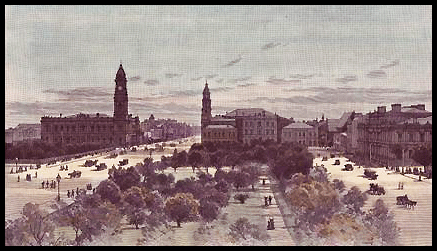 Adelaide GPO (on left) and Town Hall in the mid 1880s. From a Post Card of the original wood engraving by P. Schellinger after W.C. Fitler. |
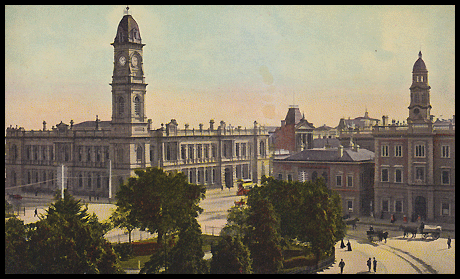 General Post Office, Adelaide in the 1890s. |
The South Australian postal authorities issued a stamp featuring the GPO Adelaide in 1899. |
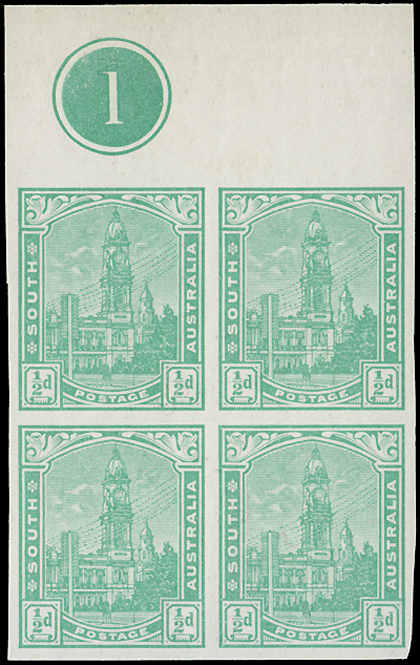 |
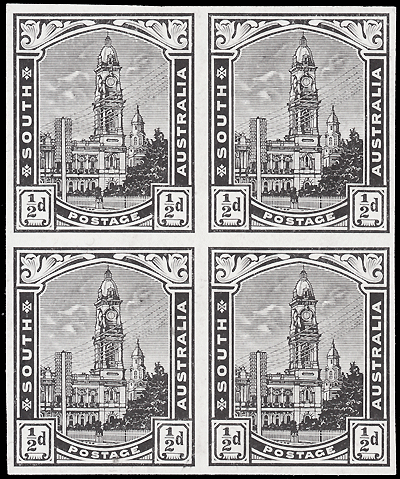 |
|
Plate proof on thin card in black. Only one sheet was printed. Status Auctions, May 2011, Lot 1513. |
Imperforate plate proof in green with Plate Number 1. Status Auctions, May 2011, Lot 1511. |
For the first line in February 1856, one room was rented in the city for the Electric Telegraph Office - first next to Neale's Exchange, and afterward, in early January 1856, on the front Ground Floor of Green's Exchange. On the other end of the first line, at Port Adelaide, a one-roomed wooden building on the wharf was deemed to be sufficient.
The first Chief Telegraph Office was a two story building located at 29 North Street. It is now the offices for the Bureau of Customs and Quarantine. In 1872, it was moved to the GPO building and was housed in the north-west corner. The Telegraph Office was moved slightly in the 1891 refurbishment. Meanwhile the North Street premises were used as the Telephone exchange from 1883.
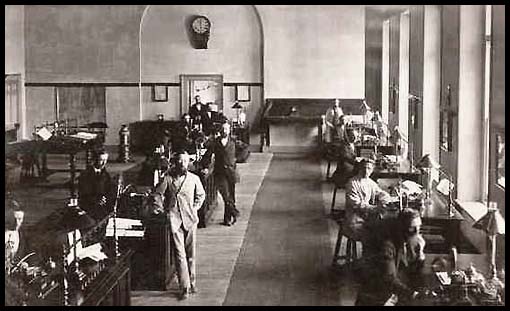 Charles Todd is the man standing in the foreground. |
One of the few images inside the Adelaide Telegraph Office in King William Street. It was taken soon after the new office was opened in or soon after 1872.
The most important part of its history was that, in 1872, the first telegraph messages from overseas were received in the Adelaide Chief Telegraph Office on the first floor of the GPO. |
The office quickly became used to completing large volumes of work. For example, on 26 July 1875, 40,000 words were transmitted from the Adelaide Telegraph Office to the other Colonies - nearly all being for the Sydney Morning Herald and the Melbourne Argus (these two papers being the signatories to the Reuters monopoly).
Colonial date stamps used at the Central Adelaide Office.
| Telegraph Office in the top half of the double circle / small dotted circle or S.A. at the base. |
||
| SC3-TO (double circle).
There are three types:
|
SA is NOT at the base. |
|
Used on delivery form SC-DO-6Ba on 13 February 1885 for a message from Sydney to Adelaide Station. |
||
| SC1-TO.
Faint circular outline.
|
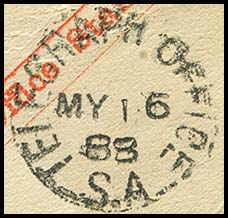 6 16 May 1888. 6 16 May 1888.Used on SC-DO-6Ca. |
|
| SC1-TO.
No date slugs.
|
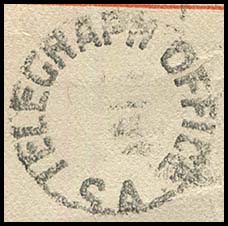 1 November 1890 (shown by inscriptions on the telegram). Used on SC-DO-6Cb. |
|
| SC1-TO.
4 mm side arcs.
|
Used on SC-DO-6Cc. |
Used on SC-DO-6B. |
Post-Federation date stamps used at the Adelaide Central Telegraph Office.
Telegraph Office/ Two distinct formats. |
||
| Squared circle. Month & day then year - all 3 mm font. Not included elsewhere (eg PMI). 1 and 2 mm separation arcs.
|
|
Squared circle cancellation
|
| Squared circle - Day (5 mm font) then month & year (3 mm font). Not included elsewhere (eg PMI). No separation arcs.
|
|
|
| Circular steel datestamp. Month/day before year.
|
|
|
Telegraphs/Adelaide.
|
Used on SI-DO-3. Provenance: Dave Elsmore. |
Chief Telegraph Office/Adelaide. Made from steel. There were at least three formats for this date stamp:
|
|
Used on an Eastern Extension (C&W) delivery form IAX-DO-4A. |
|
||
|
Used on AW-DU-9B. |
Used on AB-GMF-39B. |
|
Used on 1938 Xmas form |
|
|
|
Used on AW-DO-10 (43). |
Chief Telegraph Office/
|
|
|
|
2 digit year - year/month/day.
|
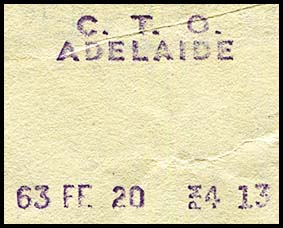 20 February 1963. Used on AA-DO-13B. |
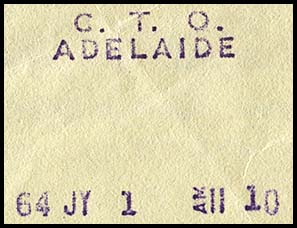 1 July 1964. Used on AA-DO-13B. |
2 digit year - year/month/day.
|
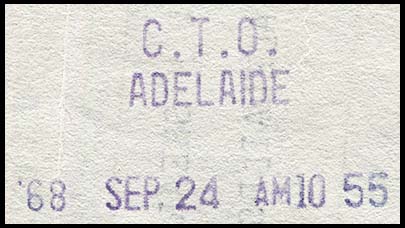 24 September 1968. Used on IAO-DO-3Bc. |
|
| G.P.O. Adelaide.
Used on a range of telegram forms from early Federation days. |
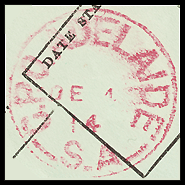 G.P.O. ADELAIDE/S.A. 1 December 1914. |
|
| Adelaide - Squared circle.
5 mm font for the day.
|
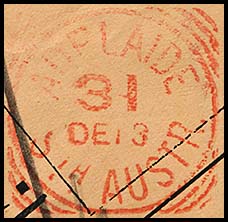 31 December 1913. Used on Urgent telegram SI-DU-2B. |
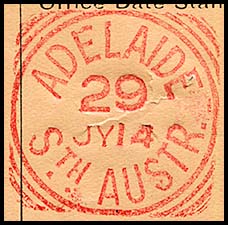 29 July 1914. Used on Urgent telegram SI-DU-2B. |
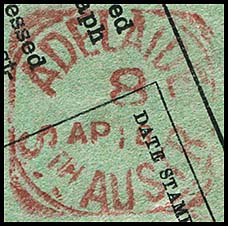 8 April 1918. Used on AE-DO-1C. |
||
|
5 mm font for the day.
|
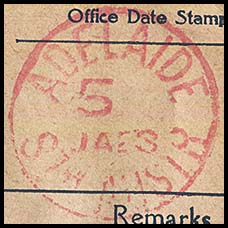 5 January 1923. Used on AB-DO-2Bb. |
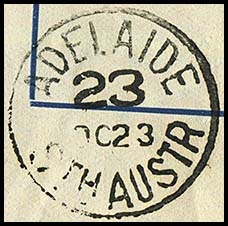 23 October 1923. Used on AB-DO-3A. |
